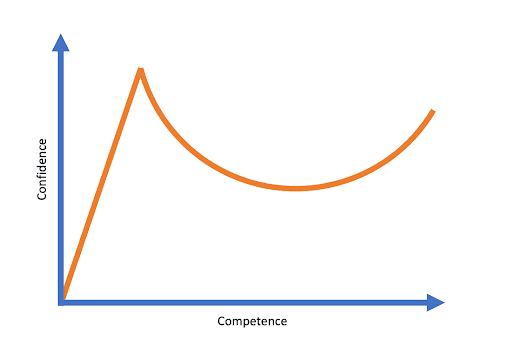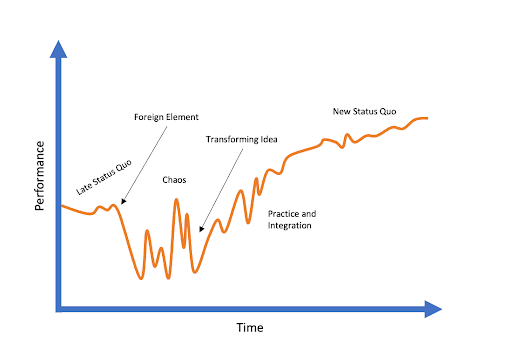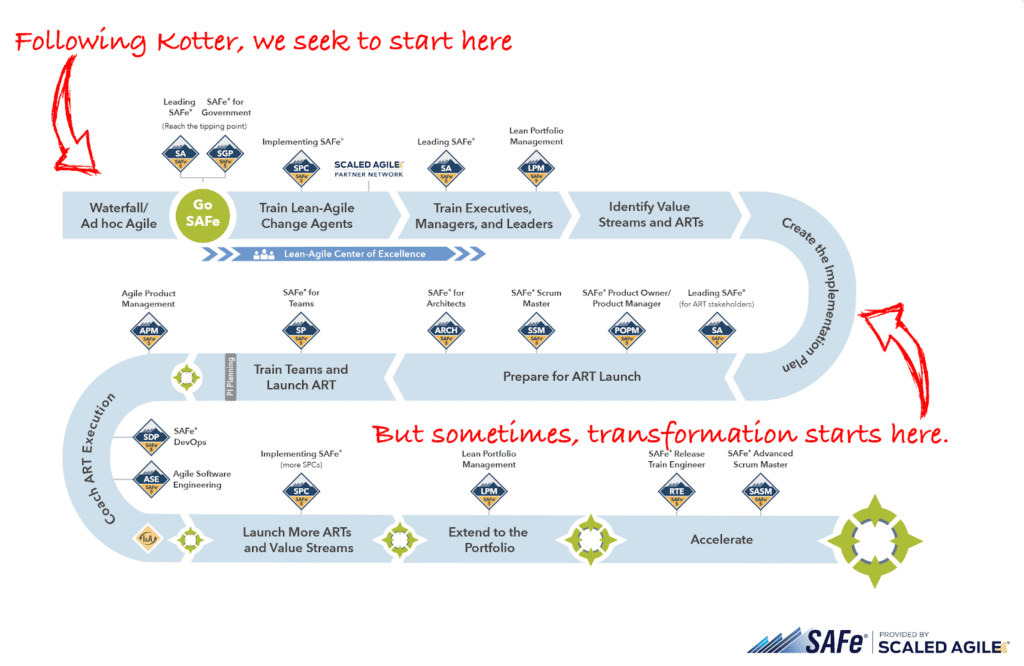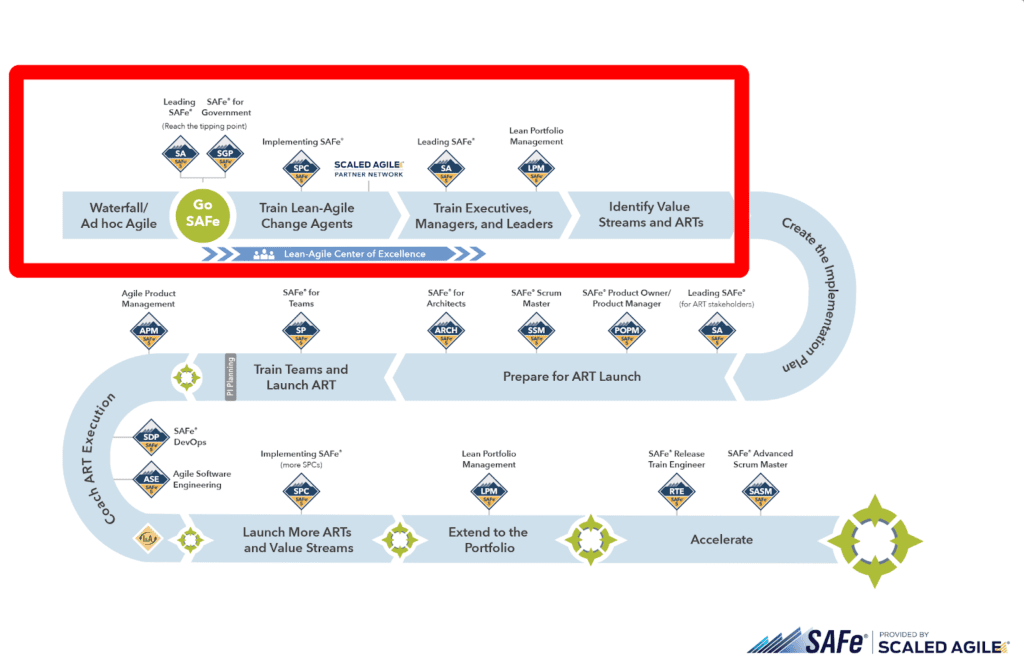Why do some people find SAFe® to be helpful in empowering teams, while others find implementing the Framework painful? To be honest, both scenarios are equally valid.
As I was beginning to refocus my career on transforming the operating models and management structures of large enterprises, I found that the behavioral patterns of Agile and the operational cadence of Scrum shined a spotlight on an organization’s greatest challenges. As a byproduct of working faster and focusing on flow, impediments became obvious. With the issues surfaced, management had a choice: fix the problems or don’t.
As we scale, the same pattern repeats, though the tax of change is compounded because change is hard. Meaningful change takes time, and the journey isn’t linear. Things get better, things get worse, then they get better again.
Consultants will often reference the Dunning-Kruger curve when selling organizational change.

The Dunning-Kruger curve illustrates change as a smooth journey. One that begins with the status quo, dips as the change is introduced, and then restores efficiency as organizations achieve competence and confidence in the new model. Unfortunately, that’s not how change works, and depicting organizational change this way is misleading.

When I’d spend time doing discovery work with a prospective client, I’d instead cite a more accurate picture of change: the Satir curve. The Satir image depicts the chaos of change and better prepares people for the journey ahead. Change is chaotic, and achieving successful change requires a firm focus on the reason why the change is important—not simply the change itself. Why, then, can a SAFe transformation (or any other change) feel painful? Here are the patterns of SAFe transformation that I observed pre-COVID.
The Silver Bullet
An organization buys ‘the thing’ (SAFe) thinking it’s a silver bullet that will solve all of their problems. For example, the inability to deliver, poor quality, dissatisfied customers, unhappy teammates, and crummy products. SAFe can help address these issues, but not by simply using the Framework. The challenge we often face is that leaders just want ‘the thing.’ Management is too busy to learn what it is that they bought. That’s OK though. They did an Agile transformation once and read the article on Wikipedia.
How can you lead what you don’t know? How can you ask something of your team that you don’t understand yourself? Let’s explore.
Start with Why
Leaders don’t take the time to understand what SAFe is, what problems it intends to help organizations solve, or the intent with which SAFe is best used. Referencing the SAFe Implementation Roadmap, its intent is to avoid some of this pain. We begin by aligning senior leaders with the problems to solve. After all, we’re seeking to solve business problems. As Kotter points out, all change must start with a compelling vision for change.
With the problem identified, we then discuss if SAFe is the best tool to address those concerns. We continue the conversation by training leaders in the new way of working, and more importantly, the new way to think to succeed in the post-digital economy.
Middle Management
Middle management, sometimes distastefully referred to as the ‘frozen middle,’ is the hardest role to fill in an organizational hierarchy. Similar to how puberty serves as the awkward stage between adolescence and adulthood, middle management is the first time that many have positional responsibility, but not yet the authority to truly change the system.
Middle managers are caught in a position where many are forced to choose between doing what’s best for the team and doing what’s best to get the next position soon. Often, when asked to embrace a Lean and Agile way of working, these managers will recognize that being successful in the new system is in contrast to what senior leaders (who bought the silver bullet but could not make time to learn it) are asking of them.
This often manifests in a conversation of outputs over outcomes. In that, success had traditionally been determined by color-coded status reports instead of working product increments and business outcomes. Some middle managers will challenge the old system and others will challenge the new system, but in either context, many feel the pain. This is the product of a changing system and not the middle manager’s fault. But it is the reason why many transformations will reset at some point. The pain felt by middle management can be avoided by engaging the support of the leadership community from the start, but this is often not the case.
Misaligned Agile Release Trains
Many transformations begin somewhere after the first turn on the SAFe Implementation Roadmap. Agile coaches will often engage after someone has, with the best of intentions, decided to launch an Agile Release Train (ART), but hasn’t understood how to do so successfully.

As a result, the first Program Increment, and SAFe, will feel painful. Have you ever seen an ART that is full of handoffs and is unable to deliver anything of value? This pattern emerges when an ART is launched within an existing organizational silo, instead of being organized around the flow of value. When ARTs are launched in this way, the same problems that have existed in the organization for years become more evident and more painful.
For this reason, many Agile and SAFe implementations face a reboot at some point. Feeling the pain, an Agile coach will help leaders understand why they’re not getting the expected results. Here’s where organizations will reconsider the first straight of the Implementation Roadmap, find time for training, and re-launch their ARTs. This usually happens after going through a Value Stream and ART Identification workshop to best understand how to organize so that ARTs are able to deliver value.

Moving Fast Makes Problems More Obvious
Moving fast (or trying to) shines a big spotlight on our problems and forces us to confront them. Problems like organizational silos, toxic cultural norms, bad business architecture, nightmarish tech architecture, cumbersome release management, missing change practices, and the complete inability to see the customer that typically surface when we seek to achieve flow.
The larger and older an organization is, the more problems there are, and the longer it takes to get to a place where our intent can be resized. Truly engaged leadership helps, but it still takes time to undo history. For example, I’ve been working with one large enterprise since 2013. It’s taken eight years since initial contact for the organization to evolve to a place that allowed them to respond to COVID confidently and in a way that actively supports global recovery. Eight years ago, the organization would have struggled to achieve the same outcome.
When I first started working with this organization, it engaged in multi-year, strategic planning, and only released new value to its customers once every three years. The conceptual architecture diagram resembled a plate of spaghetti—people spent more time building consensus than building products. And the state of the organization’s operations included laying people off with a Post-it note on their monitor and an escort off-campus.
Today, the organization is much healthier in every way imaginable. It’s vastly better than it was, but not nearly as good as it will be. The leadership team focuses on operational integrity, and how maintainable, scalable, and stable the architecture is—and recognizes that the team is one of the most important assets.
Embracing Lean and Agile ways of working at scale begins with the first ART launch. It continues with additional ART launches, a reconsideration of how we approach strategy, technology, and customers. And it accelerates as we focus on better applying the Lean-Agile mindset, values, and principles on a daily basis. This is the journey to #BecomingAgile so that we can best position the team and our assets to serve customers.
Change Is Hard
Change takes time, and all meaningful change is painful because the process challenges behavior norms. The larger the organization is, the richer the history, and the longer it may take to achieve the desired outcome. There will be good days, days when things don’t make sense, and days when the team is frustrated. But all of that is OK. You know what else is ok? Feeling frustrated during the change. It’s important to focus on why the change is taking place.
A pre-pandemic pattern (that I suspect may shift) is that change in large organizations often comes with evolution instead of revolution. With the exception of a very few clients, change begins with a team and expands as that team gains success and the patterns begin to reach other adjacent areas of the operation. The change will reach a point where supporting organizational structures must also change to achieve business agility.
As mentioned, moving fast with a focus on flow and customer-centricity exposes bottlenecks in the system. At some point, it will become obvious that structures such as procurement, HR, incentive models, and finance are bottlenecks to greater agility. And, when an organization begins to tackle these challenges, really cool things start to happen. People behave based on how they are incentivized, and compensation and performance are typically at odds with the mindset, values, and principles that are the foundation of SAFe.
Let’s Work Together
SAFe itself is not inherently painful. The Framework is a library of integrated patterns that have proven successful when paired with the intent of a Lean-Agile mindset, set of core values, and guiding principles. Organizations can best mitigate the pain associated with change by understanding what’s changing, the reason why the change is being introduced, and a deliberate focus on sound change-management practices. If you’re working in a SAFe ecosystem that feels challenging, share your experience in the General Discussion Group forum on the SAFe Community Platform. Our community is full of practitioners who represent all stages of the Satir change curve, and who can offer their advice, suggestions, and empathy. Together, we’ll make the world a better place to work.
About Adam Mattis

Adam Mattis is a SAFe Program Consultant Trainer (SPCT) at Scaled Agile with many years of experience overseeing SAFe implementations across a wide range of industries. He’s also an experienced transformation architect, engaging speaker, energetic trainer, and a regular contributor to the broader Lean-Agile and educational communities. Learn more about Adam at adammattis.com.
Share:
Back to: All Blog Posts
Next: A Twist on Professional Development: the Scrum Master Exchange Program